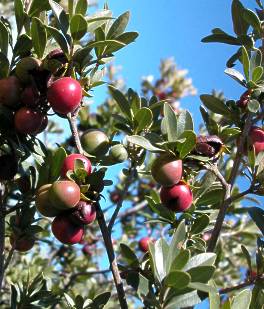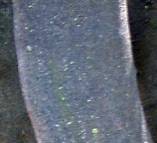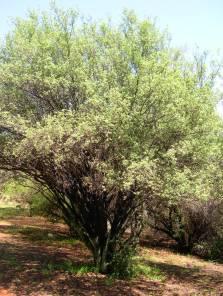Diospyros lycioides
Diospyros lycioides Desf.
Family: Ebenaceae
Common names: bluebush, star-apple, monkey plum (Eng.); bloubos (Afr.); Muthala (Venda); Lethanyu (Tswana); Monkga-nku (Southern Sotho); Mtloumana (Northern Sotho); Umbhongisa (Xhosa); Umbulwa (Zulu); Umcafudane (Swati)
SA Tree No: 605, 605.1 & 605.2
Introduction
This exciting shrub or small tree is a very tough plant which grows well country-wide. Its most attractive features are its smooth bark, blue-green leaves, fragrant flowers and colourful fruits that attract many birds and insects.

Description
Description
The bluebush is a slow to fast-growing plant, depending on the climate. It is a deciduous to evergreen shrub to medium tree up to 5 m tall with an open crown and drooping branches. It has blue-green leaves arranged spirally at the ends of the branches. The bark is dark grey to brown and smooth on older branches and stems, but covered with long hairs on young branches.

It bears tiny creamy yellow bell-shaped flowers, sweetly fragrant especially at night. The flowers attract lots of insects, especially bees, and also insectivorous bird. It is necessary to plant both female and male plants to produce the attractive deep-red marble-sized berries which are eaten by various birds, dassies, monkey and also humans. The fruit has a pleasant sweetish taste, with jelly-like flesh when ripe; the young fruit is covered by hairs, but is smooth when ripe and turns from red to reddish brown to black. It flowers from September to December and fruits from January to May.

Distribution and habitat
Distribution description
The bluebush is the most widely distributed member of the genus Diospyros, growing in its various forms all over southern Africa with the exception of the winter-rainfall area of the Cape, parts of Botswana and eastern Namibia.
D. lycoides prefers rocky habitats and well-drained soils, but is also found along stream banks. It can be thicket-forming. It varies in habit from a shrub less than 1 m high to a small timber tree, but is most common as a shrub 3 m high.
Derivation of name and historical aspects
History
The genus name comes from the Latin and refers to a plant with edible fruit. The name lycioides means resembling Lycium. The common name bloubos refer to the often bluish colour of the leaves. It is the basis of many place names: Bloubosdrift, Bloubospan, Bloubosdorn and Blouspoort in the southern Free State. The Sotho name monkga nku means smells like sheep.
The genus has about 14 species that occur in South Africa. There are four subspecies of D. lycioides which differ mainly in leaf appearance and distribution:
- Subsp. lycioides is widespread and has leaves which are smooth or slightly velvety and the lateral veins are not raised.
- Subsp. guerkei has distinctly patterned net-veined leaves and occurs on rocky, quartzite outcrops north of the Vaal River.
- Subsp. nitens has smaller leaves covered with dense, silvery hairs and is found in grasslands and rocky outcrops from Polokwane southwards to KwaZulu-Natal.
- Subsp. sericea has densely hairy, larger leaves with a raised midrib and has a mainly sub-tropical distribution, but is found in the eastern parts of South Africa.
Uses
Use
This widespread plant has many interesting and different uses. It is used to make beer. The roasted ground seeds were once used as a coffee substitute (Joffe 2001). The wood is used to build huts and to make spoons. A yellowish brown dye is obtained from the roots. The bark is used for tanning skins. The roots are chewed and used as a toothbrush. In the Karoo it is valued for its shade and shelter, but it is said to taint the milk of cows. The roots are also used medicinally by the local people in various parts of the country.

The roasted and powdered roots mixed with mutton fat, make a thorn plaster and are used to ease body pains. Nama people of Namibia, formerly South West Africa, believed that if the tree was cut with an upward stroke it would produce an emetic medicine and with a downward stroke it would be a purgative. It is reported that the Venda use it, together with gardenia, to appease the spirit of a young man who has died before marriage, as a charm to protect them from enemies.
Growing Diospyros lycioides
Grow
Diospyros lycoides grows very well in a well-drained soil in full sun. Propagate from seeds soaked in hot water overnight, as cuttings are very difficult to root. Young plants grow very fast. For best results in your own garden add lots of compost, mulch and feed with slow-release 3:1:5 fertilizer and water regularly.
Use it as a hedge or screening plant. Only female plants bear the colourful fruit. Pinching out branch tips when young will encourage a bushy plant. Another species to try in the garden is Diospyros whyteana which can be trained as a hedge or enjoyed for its glossy dark leaves.
References
- Coates Palgrave, M. 2002. Keith Coates Palgrave Trees of southern Africa. Struik, Cape Town.
- Joffe, P. 2001. Creative gardening with indigenous plants. A South African guide. Briza Publications, Pretoria.
- Joffe, P. 2003. Easy guide to indigenous shrubs. Briza Publications, Pretoria.
- Van Wyk, B. & Van Wyk, P. 1997. Field guide to trees of southern Africa. Struik, Cape Town.
- Van Wyk, B. & Gericke, N. 2000. People's plants: a guide to useful plants of southern Africa. Briza Publications, Pretoria.
- Venter, F. & Venter, J.A. 2002. Making the most of indigenous trees. Briza Publications, Pretoria.
Credits
Luambo David Rambuwani
With additions from MP Gavhi
& Yvonne Reynolds
Free State National Botanical Garden
September 2005
Plant Attributes:
Plant Type: Shrub, Tree
SA Distribution: Eastern Cape, Free State, Gauteng, KwaZulu-Natal, Limpopo, Mpumalanga, North West, Northern Cape
Soil type:
Flowering season: Early Summer
PH:
Flower colour: Yellow
Aspect: Full Sun
Gardening skill: Easy
Special Features:
Horticultural zones










Rate this article
Article well written and informative
Rate this plant
Is this an interesting plant?
Login to add your Comment
Back to topNot registered yet? Click here to register.